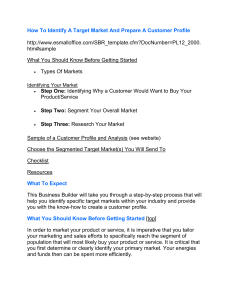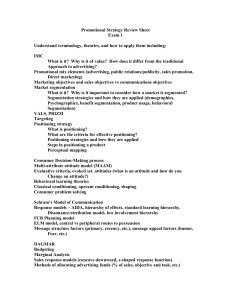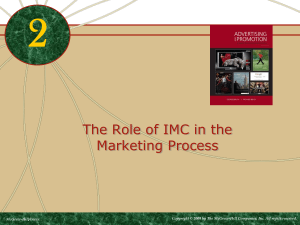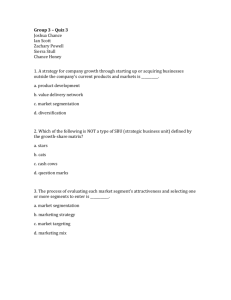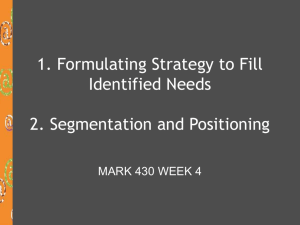PowerPoint Chapter 2
advertisement
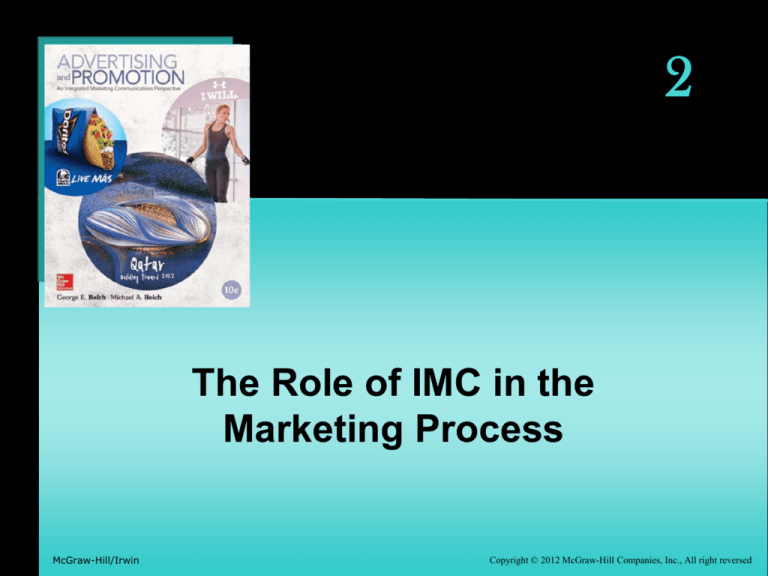
2 The Role of IMC in the Marketing Process McGraw-Hill/Irwin Copyright © 2012 McGraw-Hill Companies, Inc., All right reversed Marketing to Millennials • Gen Y born between 1982 and 2000 • Difficult to market to • Cheap / stingy / disinterested • Bad economy / no jobs / live at home • No disposable income • Mobile / tech savvy • • • • Information overload Multi-task Rather buy enhanced cell phone vs car Communicate / share info with others 2-2 Marketing to Millennials - continued • Companies trying to understand Millennials • Zipcar • Airbnb • GM concept cars with high mileage and high-tech features • Geico mobile app to access insurance • Want not just social media but content • Millenials will be loyal and tell their friends 2-3 Marketing & Promotions Process Model 2-4 Strategic Marketing Plan • The Strategic Marketing Plan Guides • Allocation of organization’s resources • Specific marketing programs and policies • Evolves from an organization’s overall corporate strategy 2-5 Opportunity Analysis • Market Opportunities • Areas with favorable demand trends • Customer needs not being satisfied • Where it can compete effectively • Market is rarely just one group, but many segments • Develop different programs targeting each segment 2-6 Competitive Analysis • Types of competition (ex. in Airline Category) • Direct (e.g. Delta, United, Lufthansa, Singapore) • Indirect (e.g. Amtrak, Greyhound, Avis) • Competitive Advantage • Something special giving edge over competition • Superior customer service / High quality product / Low cost / Memorable advertising • Analyze competitive marketing programs (including foreign competition) 2-7 The Target Marketing Process Identify markets with unfulfilled needs Determine market segmentation Select a market to target Position through marketing strategies 2-8 Identifying Markets • Identify specific needs of groups of people (segments) • Select segment to target • Develop programs to each segment • Understand consumers as much as possible to design programs to meet their needs 2-9 Market Segmentation Not possible to market to every consumer • Divide a market into distinct groups • With common needs who respond similarly to a marketing situation 2-10 Bases for Market Segmentation Demographic Geographic Behavioristic Gender Region Usage Age City size 80/20 Rule Race Metropolitan area Life stage Density Birth era Household size Psychographic Benefit Residence tenure Personality Specific need Marital status Values/Lifestyle Usually one major basis and 1-2 minor bases used 2-11 Geographic Segmentation “Cream” flavored red soda popular in South 2-12 Demographic Segmentation Targets 50+ Hispanic segment 2-13 Benefit Segmentation Eliminates split ends 2-14 Psychographic Segmentation HIGH PRIZM Social Groups $ LOW 2-15 Selecting a Target Market 1 Determine how many segments to enter 2 Determine which segments have the greatest potential • Opportunities for growth • Competition • Own ability to compete 2-16 Market Coverage Alternatives Undifferentiated One product to everyone Concentrated Differentiated Different strategies for different segments Capture large share of one segment 2-17 Market Positioning • Fitting the product to one or more segments of the market in such a way as to set it apart from competition • Image that comes to mind and attributes consumers think of (e.g.. Volvo = Safety) 2-18 Approaches to Positioning • Approaches: • Focusing on the consumer • Linking the product with the benefits the consumer will derive • Focusing on competition • Positions the product by comparing the benefit it offers versus the competition 2-19 Positioning Strategies Attributes and Benefits Price/Quality Use/Application Product Class Product Users Competitors Cultural Symbols 2-20 Positioning by Cultural Symbol 2-21 Repositioning • Alter a brand’s positioning • Declining sales • Anticipated opportunities in other market segments 2-22 The Marketing Planning Program Product Decisions Promotional Strategy Distribution Channels Price Decisions 2-23 Product Decisions More than physical object; has functional or psychological benefits BRANDING Brand Identity Brand Equity PACKAGING - Protection - Storage - Name - Logo - Symbols Intangible assets resulting from favorable image - Usage instructions - Often the first exposure to product - Makes favorable impression 2-24 Branding Apple iPhone has a strong Brand Equity 2-25 Packaging Creates Image Creates luxurious image 2-26 Pricing Decisions Factors to consider What consumers give up to buy a product or service Costs Time Demand Mental activity Competition Behavioral effort Perceived value 2-27 Relating Price to Ads and Promotions Price must be consistent with perceptions of the product Higher prices communicate higher product quality Lower prices reflect bargain or “value” perceptions Price, advertising, and distribution must be unified in identifying product position 2-28 Distribution Channels MARKETING CHANNELS Sets of interdependent organizations involved in the process of making a product available for purchase 2-29 Channels and Image • Where product is distributed sends an image to consumers 2-30 Types of Channels • Direct • Sell directly to consumer (e.g. Avon, Tupperware) • Driven by direct-response ads, telemarketing, the Internet • Often used when selling expensive and complex products (e.g. industrial products) • Indirect • Network of wholesalers and/or retailers who sell to consumers (e.g. Kraft to Shop Rite to you) 2-31 Promotional Strategies • Promotional Push • Persuade retailers to stock merchandise and promote products to consumer • Trade advertising motivates retailers to purchase product to sell to consumers • Promotional Pull • Use advertising and sales promotion to consumer • Create demand among consumers to request product from retailer 2-32 Push vs. Pull Strategies CONSUMERS Pull Strategy Push Strategy $$$ $$$ RETAILERS 2-33 Test Your Knowledge An ad in a publication aimed at veterinarians explains why they should recommend Eukanuba cat food to the owners of the cats they treat. This is an example of: A) Consumer advertising B) A promotional pull strategy C) A harvesting strategy D) A consumer promotion E) A promotional push strategy 2-34
